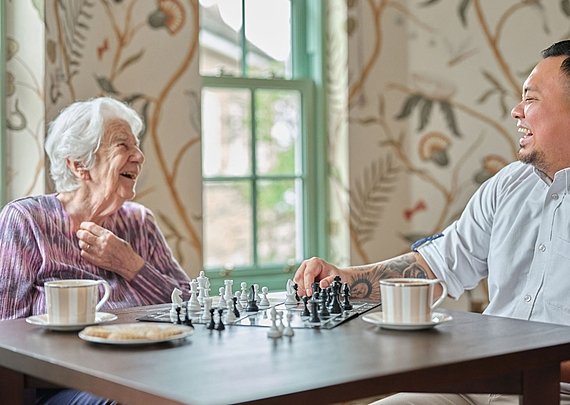192 Sloane Street, London SW1X 9QX
What Are the Benefits of Art Therapy for Dementia?
In the UK, one in 14 people aged over 65 have dementia. Although there is no cure, specialised therapy techniques can be helpful in managing symptoms and improving quality of life.
Art therapy is an evidence-based therapeutic approach that involves creative pursuits. There are many noticeable benefits of art therapy for people living with dementia, including improved memory, mood and communication skills.
At KYN, our focus is on supporting the health, wellbeing, dignity and independence of our residents living with dementia. In this guide, we will explore the relationship between art therapy and dementia, and the role it can play in care homes for dementia.
What Is Art Therapy?
Art therapy is a form of psychological therapy that aims to stimulate the brain through creativity. This may involve activities such as painting, drawing, sculpting and crafts. It is designed for people of all ages living with a physical, mental or neurological health condition.
In older adults, art therapy can play a valuable role in managing the symptoms of dementia. It can benefit those living with any form of the condition, from vascular dementia to Alzheimer's.
Art therapy aims to stimulate the brain, encourage self-expression and foster a sense of achievement. Its main goal is to improve an individual’s general wellbeing and help to maintain their quality of life.
What Are the Benefits of Art Therapy for People Living with Dementia?
For people living with dementia, art therapy has many cognitive, psychological and physical benefits. According to Art Therapy for Alzheimer’s Disease and Other Dementias, it can help to engage the attention, enhance the mood and improve a range of neuropsychiatric symptoms.
Since the review was published in 2014, further scientific studies have also supported these findings. Here are some of the most frequently noted benefits of arts for dementia.
Cognitive Benefits
The creativity, sensory input and motor skills used in art therapy help to stimulate the brain, leading to improved cognitive functioning. For people living with dementia, this can lead to:
· Improved attention and memory
· Enhanced speech and communication skills
· Improved visual-spatial abilities
· Improved orientation (awareness of self, time and place)
Short-term benefits have been found even among participants in later stages of dementia. Long-term art therapy interventions can even help to delay the overall rate of cognitive decline.
Psychological Benefits
For those living with dementia, the act of creating something often brings happiness, satisfaction and a sense of accomplishment. It also provides an opportunity for individuals to communicate non-verbally, express themselves and vent their negative emotions. In the short term, creative activities can help to uncover old memories and spark joy and laughter. Regular art therapy can improve mental wellbeing, sociability and self-worth, leading to a better quality of life. It can also reduce certain behavioural symptoms of dementia such as agitation and continuous walking.
Physical Benefits
All forms of artistic activities involve small amounts of movement, from painting to kneading clay. Regular art therapy sessions can therefore help to:
· Strengthen the hand muscles
· Improve finger flexibility and fine motor skills
· Maintain and develop hand-eye coordination
· Relieve stiffness and pain in the hands
Over time, these small hand exercises may help to prevent certain health problems developing, such as osteoarthritis.
Examples of Art Therapy Activities
Art therapy can be held one-on-one or in a group setting. It may take place in a variety of locations, such as community centres and care homes.
There are many different art activities that may be used in a therapy session. Bright colours and interesting textures are often involved, as these help to provide sensory stimulation and engage the brain. Some activities include:
· Paper crafts e.g. collage and card-making
· Sculpting with clay and dough
· Painting, drawing and colouring
· Crafting with tactile materials such as felt
· Art appreciation (e.g. visiting galleries)
Whatever medium is used, art therapy for people experiencing the symptoms of dementia is most effective when it holds personal meaning. Themes should focus on the individual’s interests, passions and life experiences (e.g. creating a collage from old photographs).
Do All Dementia Care Homes Offer Art Therapy?
In care homes, care plans to support those living with dementia should be tailored to each resident’s personality, needs and wishes. Techniques such as cognitive stimulation, art and music therapy may be offered as part of a multi-disciplinary approach. However, not all residential and nursing homes provide the same therapies and activities.
You can use the CQC website to find specialist dementia care homes in your area. If art therapy is important to you, make sure to ask about this when visiting the care home. The staff should be able to tell you whether this is something available to residents.
Discover Outstanding Personalised Dementia Care with KYN
At KYN, we provide the highest standards of residential, nursing and dementia care in calm, enriching environments. We strive to honour each individual’s unique experience of dementia, supporting residents to maintain their lifestyle and independence however possible. KYN residents benefit from a range of evidence-based practices, including art therapy, reminiscence and the Namaste approach. To learn more about our personalised approach to dementia care, contact KYN today. Fill in our online form, call +44 (0) 20 3535 1923 or email enquiries@kyn.co.uk.

